Sega released Virtua Racing in 1992, a year before their popular fighting game Virtua Fighter. Both games were developed by Yu Suzuki. He was the Ferrari fan that had created OutRun. For Virtua Racing he wanted to give the world a taste of virtual reality racing. Not necessarily in the sense of giving drivers a helmet which displayed a virtual environment but instead by generating the first Formula-1 style racer that featured 3D environments a 3D racing car and believable physics. The team at AM2 was able to craft a car and several tracks that responded very realistically. While the polygon count was still low by modern standards at the time it was revolutionary.
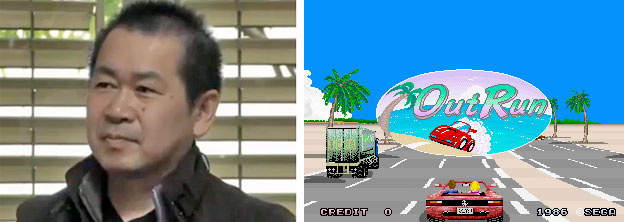
Cars would reflect light or cast a shadow depending on their position relative to the virtual sun. The exhaust on the racers would explode with sharp angled flames when downshifting, they could also bottom out on bumpy roads and send sparks flying from the undercarriage. The cars could even send up plumes of smoke from their tires if they got too loose on a turn. These details may seem insignificant and they were to many arcade visitors. They had seen sprite based racing games recreate many of those same effects. Many of the older Sega games also featured these details. The goal of Suzuki was to convince gamers that the polygon was the best tool in which to create the ultimate racing experience. While crude the flat blocky surfaces still had a sense of weight and depth unheard of in any other racer.
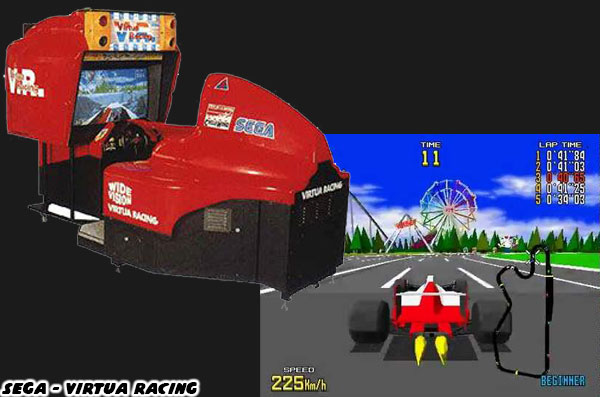
At first I was unconvinced by Virtua Racing. It certainly did look much better than Namco's Winning Run but the cars and locations were still blocky and rough. F1 Super Lap was a year older and still provided some amazing visuals. In many regards it looked better than Virtua Racing. The cars were highly detailed and not blocky at all, the courses realistic and the physics somewhat convincing. I spent a few weekends going back and forth between the games. Little by little I began to notice all of the nuances that an actual 3D engine brought to the experience. Knowing when to shift and when to brake suddenly became much more challenging. Coming up to the apex of a turn at the right angle and then accelerating past a computer rival came with a genuine sensation of speed. In sprite based games it was possible to memorize when the computer AI would go for a pass, or what landmarks to watch for when getting ready to downshift or enter a turn. That changed completely in Virtua Racing because suddenly the computer AI could adapt to the player and put cars in different positions each time they played. It was up to the gamer to become a better driver and learn to change tactics based on the opponents. It was not a sim experience, which was what had hampered Winning Run, instead it was very forgiving and played more like an arcade racer should. The game itself was selling a sense of immersion more than any fancy sit down cabinet ever could. However when the graphics and control were combined there was little reason for a car fan like myself to ever leave the arcade.
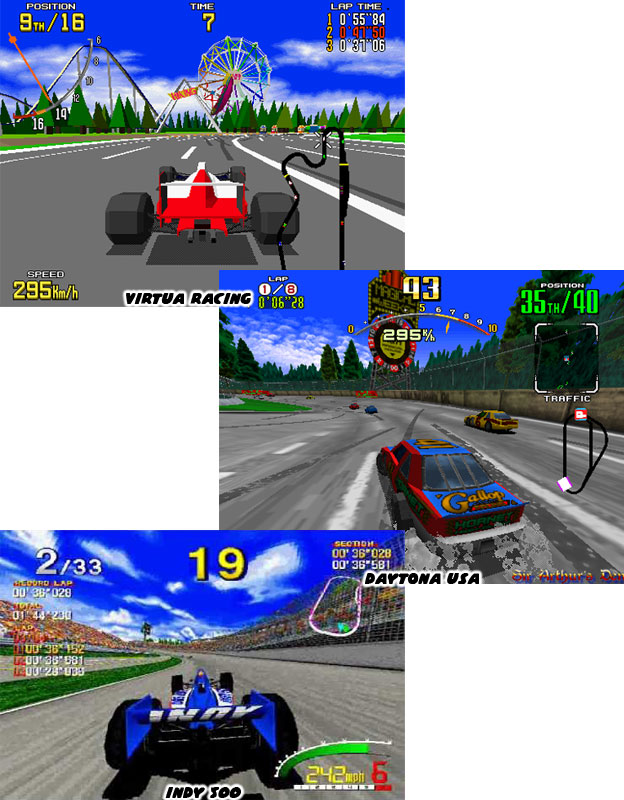
Sega did not capture the lighting in a bottle one time. They did it again and again and again. First with Virtua Racing, then with the even more well regarded Daytona USA in 1994. The funny thing was that Daytona USA actually featured less polygons than Virtua Racing, however the polygons that the engine did render were textured, giving the illusion of greater fidelity and improved graphics. It was the same thing that Namco had done to make Tekken appear graphically superior to Virtua Fighter. The leap in graphics technology did not come from in-house. General Electric Aerospace Simulation & Control Systems, which was creating polygonal rendering technology for contractors like Lockheed-Martin was shopping their technology to big companies like Disney, and Universal. Sega reached out, and visited their offices in Daytona Beach Florida. The rest as they say is history. Sega then married a more powerful rendering engine with textures in the 1995 title Indy 500. By then their domination on the racing market had all but been won.
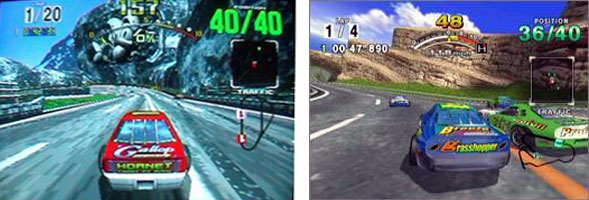
Namco had actually tried to make a better Formula-1 racer after the release of Virtua Racing. The studio had been burned by failing to break new ground with Final Lap and had beaten Sega to the 3D punch with Winning Run but both games did not generate the responses they had hoped for. So the developers went back to the drawing board. They created a new F1-like franchise that played nothing like Pole Position, Final Lap or Winning Run. The new game would be generated in 3D and feature texture mapping and other graphic nuances. The Ridge Racer team had worked with Evans & Sutherland, another military contractor to get their hardware up to spec. Ridge Racer featured contemporary looking sports cars, Ace Driver had cars and tracks that were set slightly forward in design, with only subtle science fiction elements drawn in as with Cyber Cycles.
Sadly the release of Ace Driver in 1994 and its sequel Ace Driver Victory Lap in 1995 had failed to pull many eyes away from the Sega racers. The Ace Driver games were very well done. The control was much improved over previous Namco F1 racers. It played much more like and arcade racer should have and not at all like a simulator. The designs of the cars, selection of race types and tracks were memorable as well. However the Sega game engines were more powerful and the difference in graphics capabilities was starting to become apparent to some arcade visitors.
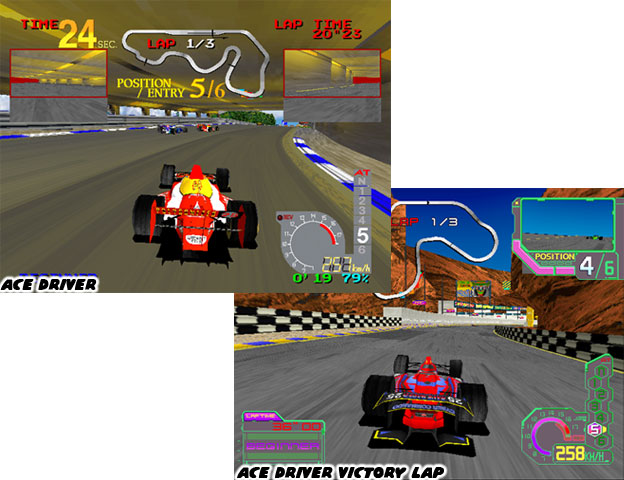
For the majority of gamers there wasn't much difference between the Sega and Namco racers. Both companies still managed to produce games and graphics far ahead of the competitors. The true rivalry was between the two companies and it seemed to peak in the mid '90s. In the first few years of the decade Namco had actually done well at responding to what Sega had just released. If there had been only two next generation F1 games then Ace Driver would have beaten out Virtua Racing by a wide margin. Unfortunately the multiple arcade R&D teams at Sega were all focused on new racing titles and had released those games in rapid succession. It was everything that Namco could do to keep from falling behind the curve. A cameo from a Tekken character would not be enough to save all of the Namco racers.
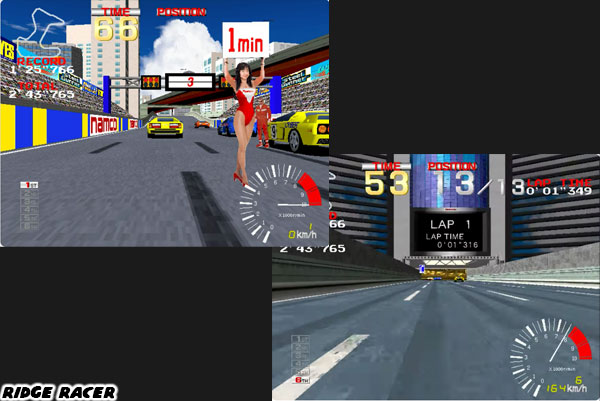
Namco was determined not to fall behind their competition. In 1993 they released one of the greatest arcade racing games of all time. Ridge Racer would become a hit in the arcades, and iconic on the upcoming Sony console known as the Playstation. We will look at this in the next blog. As always if you would like to sponsor me
please visit my Patreon page and consider donating each month, even as little as $1 would help make better blogs and even podcasts!






Virtua Racing I don't why but I was mesmerized by: octagon tires.
ReplyDeleteDaytona USA original buggy saturn version those drivers had a mind of their own, I was plotting my way to the front of the pack on Dinosaur canyon on the 2nd lap and 1 of the AI racers crashed in front of me and was flipping around. my reaction the npc car got in a accident that I had absolutely nothing do with.